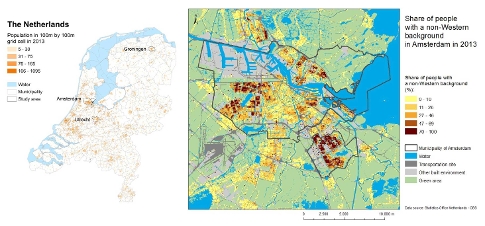Ana Petrović, Maarten van Ham (TU Delft), David Manley (University of Bristol)
The neighbourhood in which you live has a great influence on your individual income. But what exactly is the relationship between the two? The research of Ana Petrović (TU Delft), Maarten van Ham (TU Delft) and David Manley (University of Bristol) focuses on the influence of spatial inequality on individual socio-economic status. To this end, they used data from Statistics Netherlands (CBS), including (anonymised) datasets on income per residential address over time. The data have been analysed in the ODISSEI Secure Supercomputer.
The researchers carried out an exploratory analysis of the living environment at various scales. For this purpose they made grids – concentric circles around each individual person. They made the grids for different scales, varying from 100 metres to 10 kilometres. Ana: “For each scale we calculated two contextual characteristics: the proportion of residents with a non-Western background and the proportion of residents with a low income. We linked these characteristics to individual characteristics such as income. The results vary greatly between the different scales, which shows the importance of measuring spatial contextual characteristics at different scales”.
Computer power
All in all, the study had 3.4 billion data points to analyze. In the Remote Access environment of CBS, it would have taken at least four months to pass on the dataset. ODISSEI developed the ODISSEI Secure Supercomputer in collaboration with CBS and SURFsara. A secure CBS environment has been copied to SURFsara’s Cartesius supercomputer.
Lykle Voort, one of SURFsara’s developers: “The analysis of Ana required computers with at least 64GB of working memory. Because this involved a lot of combinations of data, a cluster of 25 nodes with 24 cores and 64GB of working memory each was eventually deployed. That makes a total of 600 processor cores. For comparison: a laptop usually has 2 or 4. Ana: “Without the ODISSEI Secure Supercomputer we wouldn’t have been able to carry out our research practically without it. We were even able to calculate a variable extra and a longer period of time”.
Open Access
Ana: “We are going to publish the results open access. In follow-up research, we want to better understand the spatial structure of the social environment, the trends of spatial segregation on multiple scales and the consequences of these processes for individuals. Our follow-up research will also have a lot of data points and we hope to be able to use the ODISSEI Secure Supercomputer again”.
Presentation TU Delft-pilot (2 October 2018) (pdf)
Presentation project results (25 September 2019) (pdf)


